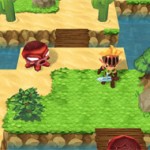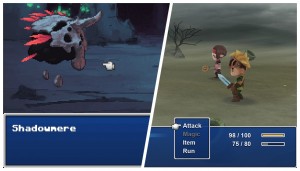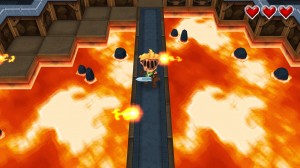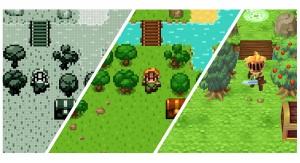 Ross Mills takes us on a quest to a retro world of 2D RPG goodness
Ross Mills takes us on a quest to a retro world of 2D RPG goodness
I should start this review with full disclosure: I only played an hour of Zelda. It was Spirit Tracks at that. I haven’t played more than ten hours of the numbered Final Fantasy games in total, and JRPGs generally don’t appeal to me. Straight off the bat, I’d sound like someone who would hate this game. As it turns out, I was very pleasantly surprised at how the game managed to get me hooked very quickly.
 At its core the game is a love letter to RPGs. More often this means Eastern-styled RPGs, but others do get a say too. As you begin the game, you are playing a 2D action RPG (think: Zelda) and you literally have one button that you can use – the “Right” key. You travel right until you pick up a chest, which allows you to travel left, then the next chest allows you to travel up and down too. Soon you come across one which allows a sword, map scrolling, and so on.
At its core the game is a love letter to RPGs. More often this means Eastern-styled RPGs, but others do get a say too. As you begin the game, you are playing a 2D action RPG (think: Zelda) and you literally have one button that you can use – the “Right” key. You travel right until you pick up a chest, which allows you to travel left, then the next chest allows you to travel up and down too. Soon you come across one which allows a sword, map scrolling, and so on.
These chests aren’t limited to game mechanics, however. You’ll find yourself also unlocking a backstory, music, sounds, and even fully-rendered 3D environments to move around in. Each one of the upgrades is more beautiful than the last (although I must admit I thought the “upgrade” from flat polygons to low-res textures was a backwards step in terms of beauty).
 These upgrades mean that the game keeps you on your toes, constantly throwing new rewards at you for completing an area, and meaning that the visuals nearly never get stagnant. Late in the game you are even allowed a limited amount of switching back-and-forth of styles, for the sake of some very well-thought-out puzzles.
These upgrades mean that the game keeps you on your toes, constantly throwing new rewards at you for completing an area, and meaning that the visuals nearly never get stagnant. Late in the game you are even allowed a limited amount of switching back-and-forth of styles, for the sake of some very well-thought-out puzzles.
Don’t come to this game expecting anything new or original, however, as with a (default) name of “Clink” and a companion named “Kaerith” the game keeps its tongue planted firmly within its cheek. Just about every trope appears, lampshaded, including a very familiar sword, extremely generic NPCs, and even a Diablo-esque section, whose dark areas require their own lighting upgrade!
 I did have to wonder if the creator was a specific fan of any particular type of RPG, as on starting I worried that they would “upgrade” to one kind of RPG (ie turn-based) and never look back. As it turns out, however, they’ve done a good job of keeping their own personal opinion out of the game and letting everyone enjoy their own areas. Any type of system isn’t around for too long, and when it is, it’s a welcome change.
I did have to wonder if the creator was a specific fan of any particular type of RPG, as on starting I worried that they would “upgrade” to one kind of RPG (ie turn-based) and never look back. As it turns out, however, they’ve done a good job of keeping their own personal opinion out of the game and letting everyone enjoy their own areas. Any type of system isn’t around for too long, and when it is, it’s a welcome change.
This is without mentioning the collectibles, the rewards for exploration, the ending boss-battle, and the card-based minigame that was enjoyable to pass a few minutes in every time you returned to a town. All of these were obviously labours of love from the creator, and really deserve a mention at the very least.
 I did have a few minor issues, however. Some areas remained inaccessible until a bit too late in the game for me to want to return to. The minimap was perhaps sorely needed earlier in the game than it appeared, and at least one enemy (a skeleton with a shield) was very difficult to handle due to having the ability to block if you hit him from the front. You never really have a solid “tell” for if you were in front or slightly to the side. These are but minor issues with an otherwise wonderful game.
I did have a few minor issues, however. Some areas remained inaccessible until a bit too late in the game for me to want to return to. The minimap was perhaps sorely needed earlier in the game than it appeared, and at least one enemy (a skeleton with a shield) was very difficult to handle due to having the ability to block if you hit him from the front. You never really have a solid “tell” for if you were in front or slightly to the side. These are but minor issues with an otherwise wonderful game.
At £7.29 (currently on Steam) you owe it to yourself to give Evoland a go if you’ve ever enjoyed RPGs of any kind. If you’re over 20, you’ll be filled the nostalgia as you slowly peer through the goggles of the past, and if you’re under 18 you’ll likely enjoy the early sections simply because they’re extremely well-crafted portions of very disparate games.
7 smashable pots filled with hearts out of 10